
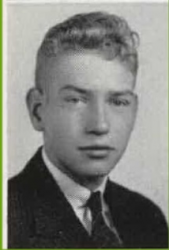 |
|
|
||
|
JOHN DAVID BRIDGERS, Sr. 'Jig' |
||||
|
Engagements: • World War II (1941 - 1945)• Korean War (1950 - 1953) |
||||
| Biography: | ||||
|
John David Bridgers, Sr. Commander, United States Naval Reserve Navy Cross & Distinguished Flying Cross John David was the son of Samuel Leon and Estelle Sheppard "Essie" Whichard Bridgers who married 08 Sep 1919 in Greenville, Pitt, NC. Samuel had been discharged from WWI service on 30 Aug 1919. John David, as he was known as a youth, had one younger sibling, Elizabeth Sutton Bridgers. Ltjg Edith Holland Hamrick, USNR, of Boiling Springs and Lt John David Bridgers, USNR, married on 27 Aug 1945 at the All Saints chapel at the Naval Air Station, Jacksonville, FL. She was a graduate of Gardner-Webb college at Boiling Springs and the Woman's College of the University of North Carolina. She taught in the city schools of Sanford before enlisting in the navy in 1943. Lt Bridgers was a graduate of East Carolina Teachers college at Greenville and had seen several years service in the Pacific. He was then chief flight instructor at Cecil Field, Jacksonville. They were the parents of six children. John grew up in Greenville, NC where his grandfather founded The Daily Reflector newspaper for whom John worked as a young man. He graduated from Greenville high school in June 1936, and he entered East Carolina Teacher College (now East Carolina University) in Aug 1936. While in college he actively participate in campus activities; Sophomore play; Senior Play, Mathematics Club, Science Club, Phi Sigma Pi; Historian; YMCA; Associate Editor; Vice-President; Class Treasurer; Pre-Med Society; Senior Superlative. In June 1940, he graduated with a Bachelor's degree. After WWII, John graduated from Duke University School of Medicine in 1950. John enlisted in the Volunteer Naval Reserve Flight Training Program (V-5) on 14 Feb 1941 in Raleigh, NC as a Seaman 2/c (NSN: 406-32-63) for a period of 4 years. He reported on temporary active duty under instruction to the Naval Reserve Aviation Base (NRAB), Opa-Locka (Miami), FL the following day to commence a 30-day elimination flight training (e-base) which had to culminate in a successful solo flight in the dreaded Yellow Peril (Stearman N3N biplane) in order to compete for selection as an Naval Aviation Cadet. Instead of being released from active duty and returned home to await further orders, Bridgers detached from NRAB, Miami and was transferred to NAS, Jacksonville (JAX), FL on 18 Mar 1941 where he remained until space was available at NAS Pensacola, FL for him to be assigned to an Aviation Cadet class. On 17 April 1941, he was detached from NAS JAX and transferred to NAS, Pensacola where he was discharged from enlisted status active duty on his own request the same day. The following day he took the oath of office and accepted in writing the appointment as an Naval Aviation Cadet (18 April 1941). His date of rank was 15 April 1941. He finished his primary flight training in Pensacola in late summer 1941. He detached from Pensacola and transferred to NAS, Miami, FL for 4-6 weeks of training with the Advanced Training Specialized Carrier Group. This was training for pilots who were assigned to planes flown from aircraft carriers. He was designated a Naval Aviator in the late summer of 1941 and he received his commission as an Ensign, USNR, A-V(N) in November 1941. Following his commissioning he returned for a month's leave in Greenville, NC. It was while he was driving home from church on Sunday, 07 Dec 1941 that he heard news of the attack on Pearl Harbor. He received word that his leave was terminated early and that he was to report immediately to Norfolk, VA. He reported in Dec 1941 for temporary duty to the Advanced Carrier Training Group (ACTG) in Norfolk, VA for 6-8 weeks of training in fleet-type planes and carrier-landing qualification. After completion of ACTG training which was marked by three successful carrier landings in an SB2U on the USS Long Island, Ensign Bridgers was to report for duty to Scout-bombing squadron 42 (VSB-42) attached to the aircraft carrier USS Ranger (CV- 4) for duty involving flying. However, the Pacific area had now become the priority. His original orders to VSB-42 were cancelled. He was to complete the training with the ACTG and then proceed with other pilots via train to San Francisco and then to Hawaii on board the transport ship S.S. President Hoover for assignment. After a weeks steaming, the Hoover reached Honolulu about 01 Mar 1942 where the thirty or so ACTG graduates were transferred across the Island of Oahu to the NAS, Kaneohe Bay. The group's assignments were spread around to various squadrons. Ensign Bridgers was assigned to USS Yorktown's Bombing Five (VB-5) for duty. However, he was temporarily assigned to Bombing Squadron Three (VB-3) attached to USS Saratoga (CV-3). The Yorktown was continuously in the southwestern Pacific area from 14 Feb 1942 until she returned to Pearl Harbor for two days on 26 May 1942. In early January 1942, Saratoga was torpedoed by a Japanese submarine. She steamed back to Bremerton, WA for repairs with her scouting and torpedo squadrons accompanying her. Saratoga's bombing and fighting squadrons remained at NAS Kaneohe Bay to augment the depleted Hawaiian air defenses. For the next month VB-3 provided a much need training ground for the rookie pilots who had never flown the Douglas SBD Dauntless dive bomber. However, an aircraft accident sent a VB-3 pilot to the hospital for repairs. Ens. Bridger's would continue to remain with VB-3. In early April, VB-3 was directed to temporarily replace Scouting Squadron Six on board USS Enterprise (CV-6). On 08 April 1942, VB-3 flew on board the Enterprise. Ens. Bridgers was the rear seat passenger with pilot Ens. Bob Elder. Five days later, Enterprise executed a rendezvous with USS Hornet (CV-8) with her deck-full of Army B-25 bombers. Doolittle's raiders took to the cloudy skies on 18 April 1942 delivering a surprise "gift" to Japan. Enterprise and Hornet returned to Hawaii on 25 April 1942. VB-3 flew off from Enterprise and returned to NAS Kaneohe. It was not until Yorktown returned to Pearl in late May that Ensign Bridges was transferred to VB-5 -- just in-time for the Battle of Midway. Ensign Bridgers learned that while he was on the Doolittle mission, many of his ACTG group ordered to VB-5 but temporarily assigned to other squadrons like himself, had flown to the southwest Pacific on board Army B-17 bombers and had reported to the USS Yorktown in time to participate in the Battle of the Coral Sea. Early on the morning of 04 Jun 1942, Ensign Bridgers was listed on the strike group flying wing on Lt Charlie "Tex" Conatser. VB-5 aircraft were spotted last on the deck as pilots manned their planes. As the preceding strike package left Yorktown, VB-5 moved up to their take-off spot only to be told to kill their engines and to return to their Ready Room. Their planes were then lowered down into the hanger bay. In the Ready Room, the pilots learned that only three of the four Japanese carriers expected had been found. As a precaution, VB-5 was split; eight planes would search for the fourth enemy carrier while ten were withheld as a back-up strike against the fourth enemy carrier if found. Unfortunately, enemy warplanes from the fourth carrier found the Yorktown first. During the attack, an enemy bomb exploded in the hanger bay shredding Ens. Bridgers plane with shrapnel and taking it out of commission. He would not fly into combat during the battle of Midway. Battle damage to Yorktown had caused the ship to list and eventually come to a stop. The Captain issued abandon ship orders to which Ens. Bridgers made his way to one of the many ropes that had been lowered. He lowered himself the 50-60 feet to the surface of the water below. According to official US Navy records, Ens. Bridgers was rescued by the destroyer, USS Russell (DD-414). Two days later he was transferred to the submarine tender, USS Fulton (AS-11) that had been ordered to sea during the battle of Midway. Fulton transported many of the Yorktown survivors, including Ensign Bridgers, back to Pearl Harbor where she arrived on 08 Jun 1942. Following his return to Pearl Harbor, Ens. Bridgers and others from VB-5 were assigned to Scouting Six (VS-6) on Enterprise. John would continue his career as a carrier-based aviator serving on the USS Enterprise (CV-6), USS Saratoga (CV-3), USS Yorktown (CV-10), USS Hornet (CV-15), USS Essex (CV-9) and USS Bunker Hill (CV-17). He flew upwards of 70 combat missions and participated in four of the five major fleet engagements in the Pacific. The actions included escort duty with the Doolittle raid, sinking of the USS Yorktown during the Battle of Midway, combat action from Henderson Field at Guadalcanal, the Battles of Santa Cruz, participating in the battle of the Palaus, the Marianas, raids against Formosa, the Bonins, the Ryukus, two major engagements -- Battle of the Philippine Sea and Leyte Gulf. In 1944, he was temporarily assigned with Air Group Fifteen on board USS Bunker Hill (CV-17) attached to Bombing Squadron Fifteen as a Lieutenant, A-V(N). In 1945, Lt Bridges was assign to the Operational Training Command in Jacksonville, FL. He became chief flight instructor of the scout-bombing training squadron at Cecil Field near Jacksonville. His awards in World War II included the Navy Cross, Distinguished Flying Cross, Five Air Medals, Presidential Unit Citation, American Defense Service Medal, Asiatic-Pacific Campaign Medal with five bronze battle stars, and the World War II Victory. From Ensign, Bridgers was promoted to Ltjg 01 Oct 1942; to Lt 01 Oct 1943; to Lcdr 01 July 1953. Promoted to CDR on the retired list. His designator was 2109. The first three digits (210) indicate a Medical Officer. The 9 represents an officer of the Naval Reserve who is retired. His pay entry base date (PEBD) was 14 Feb 1941. He retired on 09/1958.Lt Bridgers was released to inactive duty in 1946. He returned to active Service during the Korean War (1950-1954) serving as a flight surgeon with Experimental Air Group VX-3 in Atlantic City, NJ. He was released from active duty with the rank of Lieutenant Commander and advanced to grade of Commander on the US Naval Reserve retired list. During the interim between WWII and Korea, John attended and graduated from Duke University School of Medicine in 1950. He did his residency in pediatrics at Children's Hospital of Philadelphia and was Assistant Chief Resident in 1955. He was a multi-accomplished man. Lt John Bridgers married Ltjg Edith Holland "Edie" Hamrick, a native of Boiling Springs, Cleveland, NC, on 20 Aug 1945 at the All Saints Chapel, Naval Air Station, Jacksonville (NAS JAX). They met at NAS JAX where she served as a communications officer. She was accepted for enlistment 08 Aug 1943 in Raleigh, NC in the Women Accepted For Volunteer Emergency Service (WAVES). They were the parents of four sons and two daughters.Dr. John D Bridgers died on 12 May 2007 in Murfreesboro, Rutherford, TN. Edith Bridgers died on 30 Aug 2000 in Woodbridge, New Haven CT. ~ ~ ~ Navy Cross Citation The President of the United States of America takes pleasure in presenting the Navy Cross to John David Bridgers, Lieutenant, United States Naval Reserve, for extraordinary heroism in operations against the enemy while serving as Pilot of a carrier-based Navy Scout Dive Bomber and Division Leader in Bombing Squadron FIFTEEN, attached to the U.S.S. ESSEX, in action against enemy Japanese surface forces in the vicinity of the Philippine Islands during the Battle of Leyte Gulf on 25 October 1944. In command of fourteen airplanes Lieutenant Bridgers initiated the strike upon the enemy disposition and coordinated his dives perfectly with other attacking aircraft. In the face of intense and accurate anti-aircraft fire from the entire enemy formation, he obtained one of eight direct hits upon a carrier of the CHITOSE class. As leader of the dive bomber group, he so effectively disposed his aircraft that the resulting successive hits upon this ship caused it's almost immediate sinking. Undaunted in the face of relentless, devastating anti-aircraft fire, he rendered gallant service during the bitterly fought engagement in which all carriers, a light cruiser and a destroyer of the enemy's task force were sunk and heavy bomb and torpedo damage inflicted on battleships and other important naval units. By his daring airmanship, exceptional courage and steadfast devotion to duty through a perilous assignment, Lieutenant Bridgers contributed materially to the sinking of this valuable enemy fighting unit and upheld the highest traditions of the United States Naval Service. ~ ~ ~ Distinguished Flying Cross Citation The President of the United States of America takes pleasure in presenting the Distinguished Flying Cross to John David Bridgers, Lieutenant , United States Navy, for heroism and extraordinary achievement while participating in aerial flight as a Pilot in Bombing Squadron FIFTEEN, embarked in U.S.S. ESSEX, in action against an enemy air base in the vicinity of the Marianas Islands on 23 June 1944. Demonstrating great courage and ability as flight leader, he led a dive bombing attack, at a time when this base represented a serious threat to our forces. Numerous enemy planes were destroyed in dispersal areas, and resulted in a marked decrease in air operations from this quarter. His courage and skill were at all times inspiring and in keeping with the highest traditions of the United States Naval Service. ~~~~~~ Enterprise Presidential Unit Citation (1942) For consistently outstanding performance and distinguished achievement during repeated action against enemy Japanese forces in the Pacific war area, 7 December 1941, to 15 November 1942. Participating in nearly every major carrier engagement in the first year of the war, the Enterprise and her air group, exclusive of far-flung destruction of hostile shore installations throughout the battle area, did sink or damage on her own a total of 35 Japanese vessels and shot down a total of 185 Japanese aircraft. Her aggressive spirit and superb combat efficiency are fitting tribute to the officers and men who so gallantly established her as an ahead bulwark in the defense of the American nation. Actions of the Enterprise mentioned in the citation include the Gilbert and Marshalls raid of 01 Feb 1942; Wake Island raid, 24 Feb 1942; Marcus Island raid, 04 Mar 1942; Battle of Midway, 4-6 Jun 1942; Occupation of Guadalcanal, 7-8 Aug 1942; Battle of Stewart Islands, 24 Aug 1942; Battle of Santa Cruz Islands, 26 Oct 1942; and Battle of Solomon Islands, 14-15 Nov 1942. ~ ~ ~ Task Force 16 Citation Recognizing its contribution to the Doolittle Raid, 18 April 1942 On the occasion of the 50th anniversary of the Second World War, it is appropriate that we take time to reflect on the unique and daring accomplishments achieved early in the war by Task Force 16. Sailing westward under sealed orders in April 1942, only four months after the devastating raid on Pearl Harbor, Task Force 16, carrying sixteen Army B-25 bombers, proceeded into history. Facing adverse weather and under constant threat of discovery before bombers could be launched to strike the Japanese homeland, the crews of the ships and LTC Doolittle's bombers persevered. On 18 April 1942 at 14:45, perseverance produced success as radio broadcasts from Japan confirmed the success of the raids. These raids were an enormous boost to the morale of the American people in those early and dark days of the war and a harbinger of the future for the Japanese High Command that had so foolishly awakened "The Sleeping Giant." These exploits, which so inspired the service men and women and the nation live on today and are remembered when the necessity of success against all odds is required. (Signed) John H.Dalton Secretary of the Navy 15 May 1995 ~ ~ ~ Combat Action Ribbon (CR) note: Navy/Marine flight crews were not eligible for or were awarded the Combat Action Ribbon (CR) for aerial combat alone. See Navy and Marine Corps Awards Manual (SECNAVINST M-1650.1 of 16 Aug 2019, Appendix 2C.1.c (3) Amplifying Guidance). It reads in part, “The CR will not be awarded in connection with aerial flight, . . . “ The CR was established in 1969 and made retroactive to 07 Dec 1941. According to the Awards Manual, when deemed appropriate, the award for aerial combat is the Air Medal. [Bio#203 composed by Gerry Lawton (GML470)] |
||||
| Honoree ID: 319402 | Created by: GML470 | |||
Ribbons
Medals
Badges
Honoree Photos
 | 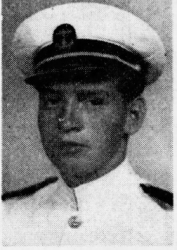 | 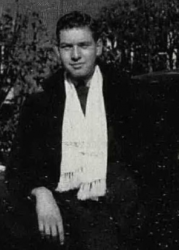 |
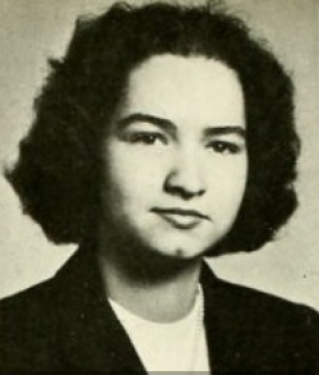 | 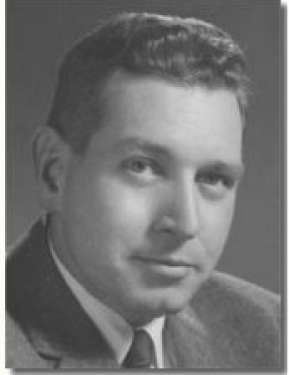 |
 |


